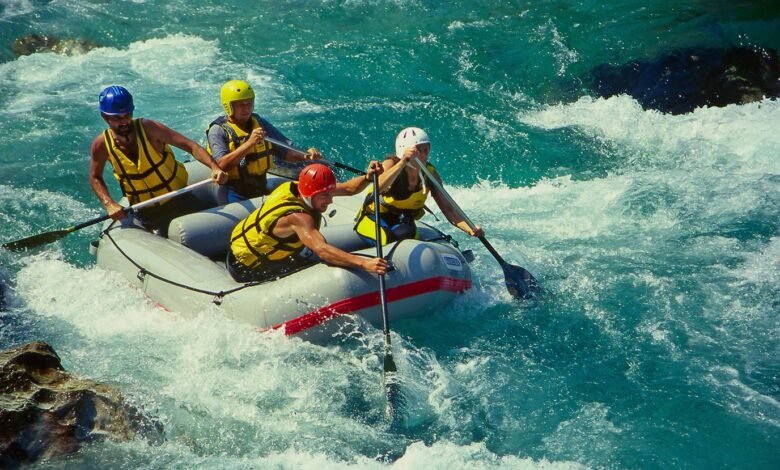6 Rafting Safety Tips Every Adventurer Should Know

This water sport is an exhilarating outdoor activity that offers both thrill and challenge. However, it is essential to prioritize safety to enjoy the experience and prevent accidents fully. Whether you’re navigating mild rapids or tackling more intense waters, understanding and adhering to safety practices is crucial. By following key guidelines, adventurers can ensure a safe and enjoyable water sports experience. Below are six critical water sports safety tips that every adventurer should be aware of before heading out on the water.
1. Always Wear a Properly Fitted Life Jacket
One of the most important safety measures in rafting is wearing a life jacket, also known as a personal flotation device (PFD). The life jacket must fit properly, as a loose or ill-fitting jacket can compromise its effectiveness. A well-fitted life jacket should be snug but comfortable, allowing for easy movement while ensuring it won’t slip off in the water. It’s important to check that all straps and buckles are securely fastened before getting into the raft. Remember, even experienced swimmers should always wear a life jacket, as the unpredictable nature of river currents can pose a significant risk.
2. Understand and Follow the Guide’s Instructions
Listening to and following the instructions of this water sports guide is critical for a safe journey down the river. Guides are trained professionals who understand the nuances of the river and how to navigate various challenges. They will provide essential information on paddling techniques, how to respond in emergencies and the best ways to maintain balance in the raft. It’s crucial to pay attention to their advice and ask questions if anything is unclear. Trusting your guide’s expertise can make a significant difference in the outcome of this water sports adventure, ensuring that you stay safe while enjoying the thrills of the river.
3. Know Your Limits and Choose the Right This water sport Level
This water sport is classified into different levels based on the intensity of the rapids, ranging from gentle flows to extreme white-water conditions. It’s important to honestly assess your experience and skill level before choosing this water sports trip. Beginners should start with lower-class rapids, which offer a more controlled environment and fewer obstacles. Attempting this water sports course that is beyond your ability can lead to dangerous situations, including capsizing or getting caught in strong currents. By selecting a trip that matches your abilities, you can build confidence and skills gradually, making the experience both safe and enjoyable.
4. Wear Appropriate Gear for the Conditions
The gear you wear can have a significant impact on your safety and comfort during this water sport. In addition to a life jacket, wearing a helmet is essential to protect your head from potential impacts with rocks or other objects in the river. Depending on the weather and water temperature, you may also need to wear a wetsuit or dry suit to maintain body warmth and prevent hypothermia. Footwear should be secure and provide good traction, such as water shoes or sandals with sturdy straps. Avoid loose clothing that could get caught on equipment or in the water, and always ensure that your gear is in good condition before setting out.
5. Practice Effective Communication Within the Raft
Clear communication among all members of this water sports team is vital for navigating the river safely. Before starting the trip, your guide will likely go over basic commands used during this water sport, such as “paddle forward,” “paddle back,” or “stop.” It’s important that everyone in the raft understands these commands and responds promptly when given. Effective communication helps coordinate paddling efforts, maintain balance, and respond quickly to changing conditions. In addition, discussing and planning for potential scenarios, such as what to do if someone falls out of the raft, can help everyone stay calm and react appropriately in an emergency.
6. Be Prepared for Self-Rescue Situations
While the goal is always to stay in the raft, it’s important to be prepared for situations where you may end up in the water. Understanding self-rescue techniques can be lifesaving in such scenarios. If you fall out of the raft, the priority is to stay calm and float on your back with your feet pointed downstream to avoid hitting obstacles. Use your arms to steer and try to make your way towards the raft or the shore. Your guide will likely attempt to bring you back into the raft, but it’s important to be proactive in your efforts to return to safety. Practicing self-rescue skills before your trip can increase your confidence and ability to handle unexpected situations on the river.
Conclusion
This water sport is an adventure that combines the beauty of nature with the excitement of navigating challenging waters. However, the key to a successful and enjoyable water sports experience lies in adhering to essential safety practices. By wearing a properly fitted life jacket, following your guide’s instructions, choosing the right water sports level, wearing the appropriate gear, maintaining effective communication, and being prepared for self-rescue situations, you can significantly reduce the risks associated with this water sport. Safety should always be the top priority, ensuring that your adventure is not only thrilling but also safe. With these tips in mind, you can embark on this water sports journey with confidence, knowing that you are well-prepared for the challenges ahead.


